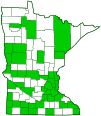sword-bearing conehead
(Neoconocephalus ensiger)
Conservation • Description • Habitat • Ecology • Distribution • Taxonomy
|
|
||||||||||||||
Description |
Sword-bearing conehead is a common, large, meadow katydid. The male is 1¾″ to 2 3 ⁄16″ in length, the female 2 1 ⁄16″ to 2½″. Both males and females have two color phases. On green phase individuals the thorax, abdomen, wings, and femurs are leaf green. There is a narrow yellowish edging on the plate covering the thorax (prothoracic shield) and on the front wing. On brown phase individuals the body is dark tan with black speckling on the wings. The female ovipositor is as long or longer than the body, and is curved, sword-like, which gives this species its common name. The top of the head extends well beyond the first segment of the antennae, forming the “cone” which gives this tribe its common name. The cone is pinched in at the sides and separated from the head by a gap. It is rounded at the tip and the lower surface is edged with black. The antennae are long, slender, and hair-like. They are much longer than the body. The wings are narrow and long, extending beyond the end of the abdomen. They have fewer than 8 longitudinal veins. The front wings slope over the sides of the body, with only a small portion near the base being horizontal. The male has sound-producing organs, a raised hardened vein at the anal edge of the right front wing (scraper) and a toothed vein (file) near the base of the left front wing. The last segments of the leg (tarsus), corresponding to the foot, has four segments. |
Size |
Male: 1¾″ to 2 3 ⁄16″ Female: 2 1 ⁄16″ to 2½″ |
Song |
The song of the male is distinctive. It is often compared to the sound of a distant locomotive. It is a continuous series of high-pitched lisps, clearly separated, produced at the rate of 10 per second. |
Similar Species |
Habitat |
Moderately moist grassy areas |
Ecology |
Season |
July to September |
Behavior |
They are strong fliers. They sometimes come to lights. By rubbing the file against the scraper the male produces a high-pitched lisping song. At low temperatures nearby males synchronize their lisps. They are often heard at night but seldom seen in daylight. During the day they perch head down on the lower stalk of vegetation with only their wings and hindlegs visible, appearing like a grass blade. At night females can be found near calling males feeding on the seedhead of a grass plant. |
Life Cycle |
The female uses her long ovipositor to inject eggs into the crown of grass clumps. Most of the eggs overwinter. In the spring the nymphs feed on grass flowers and developing seeds. |
Nymph Food |
Grass flowers and developing seeds |
Adult Food |
Seeds of grasses and sometimes sedges. |
Distribution |
||
|
Sources |
|
| 2/2/2025 | ||
Occurrence |
||
|
||
Taxonomy |
|
Order |
Orthoptera (grasshoppers, crickets, and katydids) |
Suborder |
Ensifera (katydids, crickets, and allies) |
Infraorder |
Tettigoniidea (katydids, wētā, and allies) |
Superfamily |
Tettigonioidea |
Family |
Tettigoniidae (katydids) |
Subfamily |
Conocephalinae (coneheads and meadow katydids) |
Tribe |
Copiphorini (coneheads) |
Genus |
Neoconocephalus (common coneheads) |
Some sources recognize seven subfamilies of katydids (family Tettigoniidae). However, most online sources, including ITIS, NCBI, BugGuide.net, and Orthoptera Species File (OSF) Online, demote the subfamily Copiphorinae (coneheads) to the tribe Copiphorini (coneheads) under the subfamily Conocephalinae (meadow katydids). |
|
Subordinate Taxa |
|
|
|
Synonyms |
|
Conocephaloides ensiger Conocephalus ensiger |
|
Common Names |
|
sword-bearing conehead swordbearer |
|
Glossary
Femur
In insects, the largest, most robust segment of the leg, coming immediately before the tibia. In humans, the thigh bone.
Ovipositor
A tube-like organ near the end of the abdomen of many female insects, used to prepare a place for an egg and to place the egg.
Prothoracic shield
The hardened plate on the dorsal surface of the first segment of the thorax.
Visitor Photos |
||
Share your photo of this insect. |
||
This button not working for you? |
||
Dan W. Andree |
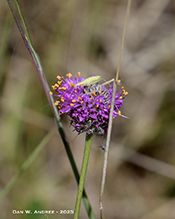 |
A strange little creature that kind a looks like it could be an earlier stage of some type katydid nymph |
Nancy Falkum |
||
Oronoco Prairie SNA Rough Blazing Star ‘Liatris aspera’ w/ Brown Katydid (?) ‘Neoconocephalus ensuger’ |
||
 |
 |
|
Jolene Burgess |
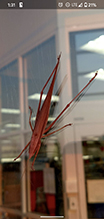 |
Walking into CVS Pharmacy. It was on the glass beside the doors to the entrance. I have never seen one of these before. |
Bill Reynolds |
||
Grabbing a gas can to fill the lawn tractor, I noticed this green leaf and thought no more about it. But, while filling the tank, my mind said to look again for the leaf had legs. Sure enough it did! |
||
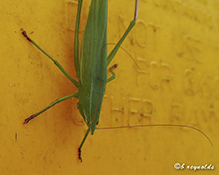 |
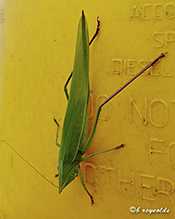 |
|
MinnesotaSeasons.com Photos |
||
|
||
|

Slideshows |
|

Visitor Videos |
||
Share your video of this insect. |
||
This button not working for you? |
||
|
Other Videos |
||
Sword Bearing Conehead Katydid (Neoconocephalus Ensiger) Male |
About
Published on Aug 1, 2016 |
swordbearingconehead |
About
Published on Aug 28, 2015 A male Neoconocephalus Ensiger (Sword-bearing Conehead) of the Tettigoniidae (Katydids or Bush Crickets) family of insects, sub-family Copiphorinae (Coneheads). Thank you for watching and sorry about the shoddy camera work! |
Sword-bearing Conehead Katydid 7-21-13 |
About
Published on Jul 25, 2013 What a handsome Sword-bearing Conehead - and in full song! - courtesy of Naturalist Linda Gilbert. This video was shot in her backyard about 9:45 p.m. "It's amazing how fast it can rub those wings together," says Naturalist Linda. "One not-well-known fact about insect songs is that when it is hot outside, the insects are singing at a great risk - the verge of death! The friction generated by their wings rubbing together creates heat, and when that's combined with the heat of the day or night, the resulting temperature is almost enough to denature their body enzymes. It really is a wonder that they don't just burst into flames!" |

Visitor Sightings |
||
Report a sighting of this insect. |
||
This button not working for you? |
||
Dan W. Andree |
Location: Norman Co. Mn. A strange little creature that kind a looks like it could be an earlier stage of some type katydid nymph |
 |
Nancy Falkum |
Location: Oronoco Prairie SNA |
 |
| Jolene Burgess 3/13/2020 |
Location: Plymouth, Minnesota Walking into CVS Pharmacy. It was on the glass beside the doors to the entrance. I have never seen one of these before. |
MinnesotaSeasons.com Sightings |
||

Created 8/14/2016 Last Updated: © MinnesotaSeasons.com. All rights reserved. |
